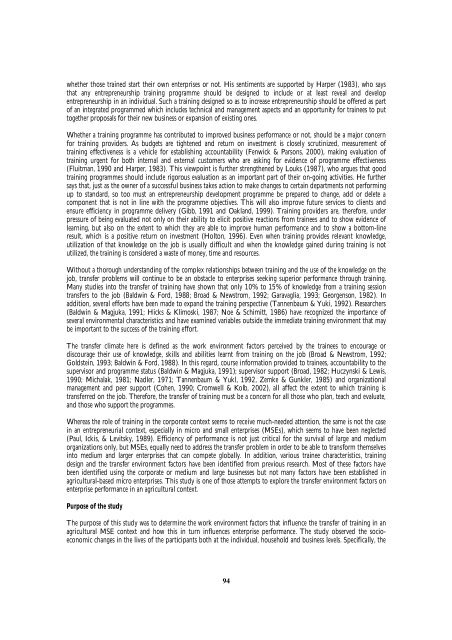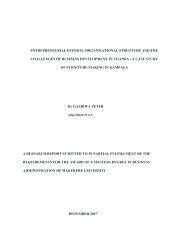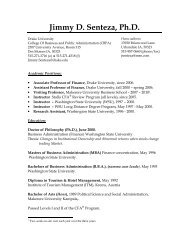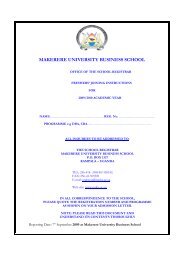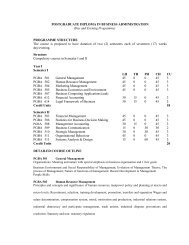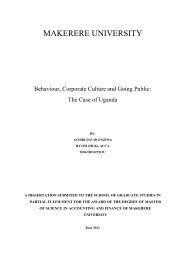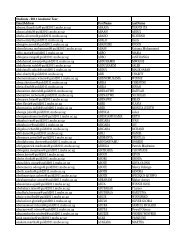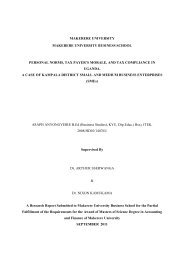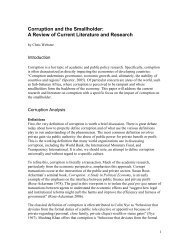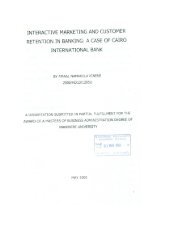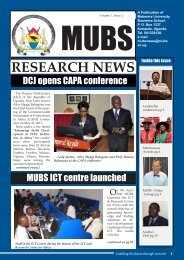13th Annual International Management Conference Proceeding
13th Annual International Management Conference Proceeding
13th Annual International Management Conference Proceeding
Create successful ePaper yourself
Turn your PDF publications into a flip-book with our unique Google optimized e-Paper software.
whether those trained start their own enterprises or not. His sentiments are supported by Harper (1983), who says<br />
that any entrepreneurship training programme should be designed to include or at least reveal and develop<br />
entrepreneurship in an individual. Such a training designed so as to increase entrepreneurship should be offered as part<br />
of an integrated programmed which includes technical and management aspects and an opportunity for trainees to put<br />
together proposals for their new business or expansion of existing ones.<br />
Whether a training programme has contributed to improved business performance or not, should be a major concern<br />
for training providers. As budgets are tightened and return on investment is closely scrutinized, measurement of<br />
training effectiveness is a vehicle for establishing accountability (Fenwick & Parsons, 2000), making evaluation of<br />
training urgent for both internal and external customers who are asking for evidence of programme effectiveness<br />
(Fluitman, 1990 and Harper, 1983). This viewpoint is further strengthened by Louks (1987), who argues that good<br />
training programmes should include rigorous evaluation as an important part of their on-going activities. He further<br />
says that, just as the owner of a successful business takes action to make changes to certain departments not performing<br />
up to standard, so too must an entrepreneurship development programme be prepared to change, add or delete a<br />
component that is not in line with the programme objectives. This will also improve future services to clients and<br />
ensure efficiency in programme delivery (Gibb, 1991 and Oakland, 1999). Training providers are, therefore, under<br />
pressure of being evaluated not only on their ability to elicit positive reactions from trainees and to show evidence of<br />
learning, but also on the extent to which they are able to improve human performance and to show a bottom-line<br />
result, which is a positive return on investment (Holton, 1996). Even when training provides relevant knowledge,<br />
utilization of that knowledge on the job is usually difficult and when the knowledge gained during training is not<br />
utilized, the training is considered a waste of money, time and resources.<br />
Without a thorough understanding of the complex relationships between training and the use of the knowledge on the<br />
job, transfer problems will continue to be an obstacle to enterprises seeking superior performance through training.<br />
Many studies into the transfer of training have shown that only 10% to 15% of knowledge from a training session<br />
transfers to the job (Baldwin & Ford, 1988; Broad & Newstrom, 1992; Garavaglia, 1993; Georgenson, 1982). In<br />
addition, several efforts have been made to expand the training perspective (Tannenbaum & Yuki, 1992). Researchers<br />
(Baldwin & Magjuka, 1991; Hicks & Klimoski, 1987; Noe & Schimitt, 1986) have recognized the importance of<br />
several environmental characteristics and have examined variables outside the immediate training environment that may<br />
be important to the success of the training effort.<br />
The transfer climate here is defined as the work environment factors perceived by the trainees to encourage or<br />
discourage their use of knowledge, skills and abilities learnt from training on the job (Broad & Newstrom, 1992;<br />
Goldstein, 1993; Baldwin & Ford, 1988). In this regard, course information provided to trainees, accountability to the<br />
supervisor and programme status (Baldwin & Magjuka, 1991); supervisor support (Broad, 1982; Huczynski & Lewis,<br />
1990; Michalak, 1981; Nadler, 1971; Tannenbaum & Yukl, 1992, Zemke & Gunkler, 1985) and organizational<br />
management and peer support (Cohen, 1990; Cromwell & Kolb, 2002), all affect the extent to which training is<br />
transferred on the job. Therefore, the transfer of training must be a concern for all those who plan, teach and evaluate,<br />
and those who support the programmes.<br />
Whereas the role of training in the corporate context seems to receive much-needed attention, the same is not the case<br />
in an entrepreneurial context, especially in micro and small enterprises (MSEs), which seems to have been neglected<br />
(Paul, Ickis, & Levitsky, 1989). Efficiency of performance is not just critical for the survival of large and medium<br />
organizations only, but MSEs, equally need to address the transfer problem in order to be able to transform themselves<br />
into medium and larger enterprises that can compete globally. In addition, various trainee characteristics, training<br />
design and the transfer environment factors have been identified from previous research. Most of these factors have<br />
been identified using the corporate or medium and large businesses but not many factors have been established in<br />
agricultural-based micro enterprises. This study is one of those attempts to explore the transfer environment factors on<br />
enterprise performance in an agricultural context.<br />
Purpose of the study<br />
The purpose of this study was to determine the work environment factors that influence the transfer of training in an<br />
agricultural MSE context and how this in turn influences enterprise performance. The study observed the socioeconomic<br />
changes in the lives of the participants both at the individual, household and business levels. Specifically, the<br />
94


